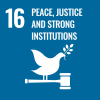
INTRODUCTION
In a context marked by declining trust in public institutions and reduced fiscal space in many countries, supreme audit institutions (SAIs) play a key role in strengthening transparency and accountability in public institutions.
The mandates of SAIs are generally aimed at promoting the transparency, efficiency, effectiveness and accountability of the public sector and improving the performance of government institutions. Initially focused on government compliance and financial auditing, SAIs’ mandates have been expanded to assess the economy, efficiency and effectiveness of public spending and government performance.
SAIs can use their mandate to assess government efforts to implement the Sustainable Development Goals (SDGs), complementing other accountability institutions and actors (such as parliaments, civil society and the media) and governments’ internal monitoring and evaluation systems.
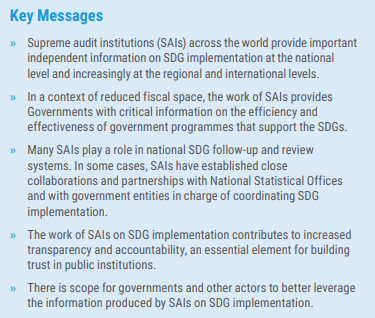
Before the adoption of the 2030 Agenda for Sustainable Development, the engagement of SAIs with internationally agreed development goals was limited. Since 2016, this has changed significantly. Individual SAIs at the national level and groups of SAIs working under the umbrella of the International Organization of Supreme Audit Institutions (INTOSAI) have engaged in supporting the implementation of the SDGs in various ways, including through conducting audits of progress on SDG targets or their national equivalents, as well as audits of national programmes supporting SDG implementation. This work has resulted in tangible impacts on national policies, programmes and institutional arrangements in support of the SDGs.
This brief highlights how the work of SAIs is informing SDG implementation, follow up and review. It provides a brief overview of SAIs’ engagement with the SDGs. This is followed by a snapshot of the current work of SAIs on SDGs and of their impacts. Finally, it reflects on the role of SAIs in national SDG follow-up and review systems.
SAIs AND THE SUSTAINABLE DEVELOPMENT GOALS
As time passed after the adoption of the 2030 Agenda for Sustainable Development, the SDGs were increasingly integrated into national contexts. Many countries adopted the SDGs as a reference framework for their own actions, through establishing national objectives and targets to match the global SDG targets and aligning national development strategies and plans—and in some cases budget processes—to the SDGs. National follow-up and review systems were put in place, with the adoption of national SDG indicators. In many countries, these changes have brought the SDGs squarely into the domestic policy sphere, which has paved the way for SAIs to legitimately include SDGs in their scope of inquiry.
The significant engagement of SAIs in SDG-related work stems in a large part from the strong and early commitment of INTOSAI to the SDGs. INTOSAI’s strategic plan for 2017- 2022 recognized SAIs’ support to the follow-up and review of the SDGs as a cross-cutting priority. The next strategic plan of INTOSAI (2023-2028) continues to promote the role of SAIs in auditing SDG implementation, providing institutional continuity in this regard.
Commitments made by INTOSAI to support SDG implementation have been matched by several global initiatives by the INTOSAI Development Initiative (IDI), INTOSAI’s capacity development arm, to promote the SDGs and support capacity building on SDG-related audits in SAIs globally. These capacity development initiatives were based on the belief that auditing the SDGs would require different capacities than those usually available to SAIs for conducting “traditional” audits. One of the important differences identified by IDI was that assessing the performance of government action in relation to SDGs (as a whole or in relation to specific goals and targets) would require a whole-of-government perspective, as opposed to the traditional focus of SAI work on specific government entities or programmes. Directly stemming from this was the need to pay attention to policy coherence.
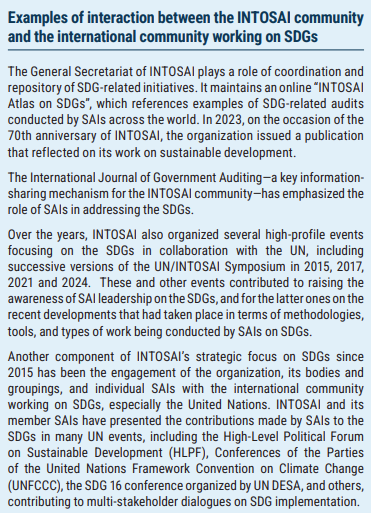
The initial focus of IDI was on audits of governments’ preparedness to implement the SDGs. The next step taken by IDI was to develop a model for audits of SDG implementation. This effort aimed to provide conceptual and practical guidance to SAIs that wanted to undertake SDG audits, and to facilitate the institutionalization of SDG audits in SAIs. The first version of the model, called ISAM, was issued in 2019. The model was revised in 2024 and complemented by two guidance documents on policy coherence and leaving no one behind. IDI also led several initiatives involving multiple SAIs to pilot the model on specific SDG areas, including gender equality (SDG 5), sustainable public procurement (target 12.7), strong and resilient national public health systems (linked to SDG 3.d), and more recently climate change adaptation (SDG 13). Other goal areas have been covered by initiatives coming from INTOSAI’s structures and regions. For instance, several coordinated audits were conducted in INTOSAI’s regional group for Latin America and the Caribbean, OLACEFS, including on environmentally protected areas (SDG 14 and 15). Coordinated audits involving several SAIs have also been conducted by SAIs in the Pacific and in anglophone Africa. INTOSAI’s Working Group on Environmental Auditing (WGEA) has been leading several initiatives on SDGs and related topics, including climate change, building the capacity of its members to engage with the SDGs.
In this context, the take-up of SDG-related work by SAIs has been growing. Many SAIs have integrated SDG-related audits in their strategic plans, which usually cover 3 to 5 years. In the INTOSAI Global Survey conducted in 2023, two-thirds of all SAIs reported having undertaken audits of the SDGs (in any form) during the period 2020-2022 (Figure 1). The same survey showed that about half of SAIs globally had conducted audits of the government’s preparedness to implement the SDGs, and more than 40 percent had undertaken performance audits on national implementation of the SDGs. About half of SAIs were also carrying out audits of specific SDGs. This work is often done without being linked with the formal SDG follow-up and review system (for instance, VNR processes), as only 22 percent of SAIs reported carrying out audits for the purpose of the country reporting against SDG targets. Of note, the proportions of SAIs carrying out various strands of work on SDGs was not significantly different in LDCs compared with the global average. On the other hand, SAIs in SIDS were on average less involved in this type of work. Several countries, even though they may not have conducted SDG audits per se, have taken the step to map their audit reports along the SDGs. Examples include Argentina, Canada, North Macedonia, Sweden, and the USA.
Collectively, audits of SAI cover all the goals (see Figure 2). This illustrates that SAI audits are highly relevant to SDG implementation, as they can inform governments about their performance in all the SDG areas.
IMPACTS OF SAIs’ WORK ON SDGs AT THE NATIONAL LEVEL
Work done by SAIs on SDGs has had significant impacts on national policies and programmes, institutional arrangements, internal working processes in government entities, monitoring systems, and more generally on enhancing transparency and accountability.
Typical examples of audit impacts reported by SAIs regarding national legal and regulatory frameworks include: assessments of the adequacy of the legal framework; the tabling of new legislative bills or changes to the law and regulations made in response to audit recommendations; the development of new sectoral strategies; and commitments made by the government to establish roadmaps with timeline and budget to meet policy goals.
In terms of institutional mechanisms, examples mentioned by SAIs refer to governments establishing coordination mechanisms for SDG implementation or for achieving complex policy objectives (for instance, food security and climate change).
Examples of impacts of SAI audits on internal working processes in government include: adapting the budget framework to better reflect the gender dimension, better track expenditures in specific areas, or better integrate national sustainability goals into the budget process; changes to the rules of public procurement to include sustainability criteria; improvements in monitoring and reporting systems; more effective use of information systems to manage government programmes; and improved management of public assets.
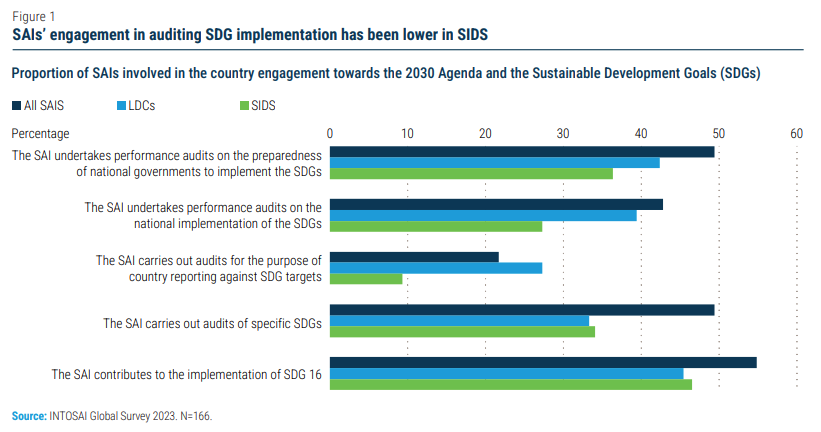
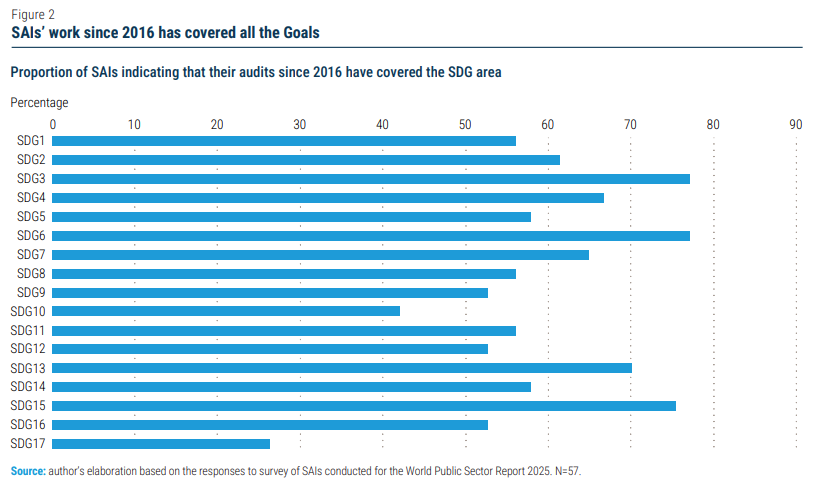
SAIs have promoted transparency and accountability on SDG implementation through, among others: assessing whether governments are effectively implementing policies and programs aligned with the SDGs; examining SDG-related programmes at different tiers of government to hold government agencies more accountable towards SDG targets; and evaluating whether public funds intended for sustainable development are used effectively and efficiently. Some SAIs underline how these actions more broadly contribute to increasing public trust, both directly through increasing transparency on the actions of the government, and indirectly by producing information that is used by other actors in the accountability system, for example, information on public procurement.
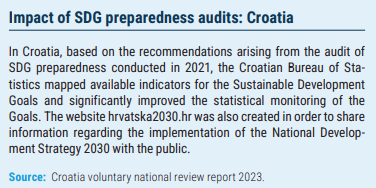
Ultimately, the impact of SDG audits is twofold. On the one hand, their findings and recommendations can contribute to improving policy design and implementation in all SDG areas. On the other hand, audits provide independent and objective evaluations that strengthen the transparency and accountability of SDG implementation at the country level. This increases the legitimacy and credibility of the SDGs, contributing to reinforcing ownership and support for the 2030 Agenda.
SAIs AND NATIONAL SDG FOLLOW-UP AND REVIEW SYSTEMS
National SDG follow-up and review systems have become increasingly developed and institutionalized since the adoption of the 2030 Agenda. SAI audits have had direct impacts on national institutional arrangements to implement the SDGs. Audits of government preparedness conducted between 2017 and 2019 provided important information to governments, highlighting challenges and gaps that required addressing. They provided key insights on the performance of institutional arrangements for SDG implementation; on means of implementation mobilized by Governments; and on data and information systems relating to the SDGs. The impacts of these audits included the adoption of legislative frameworks; the establishment of coordination mechanisms for SDG implementation at various levels; changes in approaches to sustainable development planning and reporting; improvements in national SDG monitoring systems; and the establishment of monitoring, periodic consultations and other accountability processes that increased the participation of stakeholders in SDG implementation.
SAIs are not usually part of the formal national institutional arrangements for SDG follow-up and review, although there are exceptions. In some cases, the SAI is part of the high-level coordination mechanisms, working groups, or expert groups put in place to coordinate the implementation or monitoring of SDGs. Already by 2021, several SAIs were in that position, including in Chile, Costa Rica, Maldives, the Philippines, and Samoa. The case of the SAI of Finland is also notable, as it is part of the 4-year cycle that was put in place by the Government in 2017 to review the implementation of the SDGs in the country.
Despite this, SAIs have contributed to the strengthening of national SDG follow-up systems through different channels. The first channel is the production of SDG-related information. The work of SAIs on SDG issues provides governments with findings and recommendations relating to the strengths and weaknesses of public programmes. Whole-of-government audits of SDG implementation have provided insights and recommendations that the government can take up to improve institutional arrangements.
A second channel is the strengthening of relationships between SAIs and other national actors involved in SDG follow-up and review. For instance, several SAIs from both developing and developed countries (Austria, Malta, Morocco, Norway, Oman, Pakistan, Poland, Russia and Samoa) report new or intensified collaboration and partnerships with National Statistical Offices (NSOs), with a focus on SDG indicators and the production or exchange of SDG-related data. Other SAIs have strengthened their relationships with parliaments and with government entities in charge of coordinating SDG implementation.
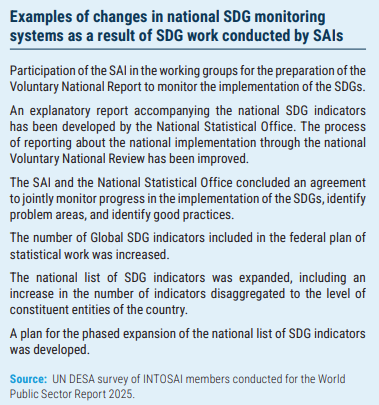
The formal involvement of SAIs in voluntary national reviews (VNRs) produced by governments to present at the United Nations has been limited to date. However, there are notable examples of engagement, for example, in Angola and Argentina. The SAI of Samoa is an observer member of the National SDG Taskforce and was involved in the public consultations and data validation of the country’s second and third VNRs. In 2021, the SAI of Indonesia (BPK) conducted a review of the Government’s VNR, using the United Nations’ voluntary guidelines for the VNR as the source of criteria for the review. The publication of this review was presented in a press release by BPK as “a good synergy and collaboration” between BPK and the Government in improving the quality and credibility of the VNR process.
In the other direction, VNR reports presented by Governments sometimes refer to the work of SAIs, in relation to both SDG audits and their contributions to the VNR itself. Starting in 2018, references to audits of SDG preparedness began to appear in VNR reports (Jamaica). In 2019, more VNR reports referred to SAIs (Argentina, Burkina Faso, Chile, Costa Rica, Ghana, Indonesia, Jamaica, Kuwait, Saint Lucia, Sierra Leone, Tonga, Turkey). In 2023, the VNR reports of Belgium and Croatia included sections on the audit of SDG preparedness conducted by the SAI and the follow-up conducted by the Government.
CONCLUSION
SAIs play a key role in support of the 2030 Agenda and the SDGs. As established domestic accountability institutions, they contribute to improving government performance by informing national monitoring and evaluation systems with independent evaluations of the effectiveness of policies and programmes related to the SDGs, and increasingly by assessing government’s performance on national SDG targets.
Both at the national and international level, there is scope for better leveraging the information produced by SAIs on SDG implementation. SAIs often provide information that would not be otherwise available to other parts of SDG follow-up and review systems. In addition, through producing information about government performance and framing it in ways that are easily comprehensible and actionable, they can enable increased engagement of the public in the monitoring of SDG implementation and ultimately reinforce government accountability and public trust in institutions.
Many of the methods, tools and capacities that have been developed by SAIs to audit the SDGs will remain fully relevant in the context of a post-2030 sustainable development agenda as well as in national contexts, where evaluating the performance of governments in pursuing national sustainable development objectives will continue to be a priority.
 Welcome to the United Nations
Welcome to the United Nations
